Around 200 million industrial workers, employees, farmers and agricultural laborers observed a two-day general strike in India on March 28 and 29. The strike was working people’s challenge to the far-right government of Prime Minister Narendra Modi. This video was created by People’s Dispatch.
Related Articles
Related Articles
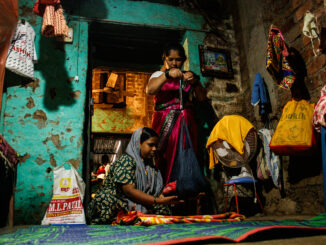
Childhood Immunization Schedules Increasingly Delayed in India As Floods and Other Climate Change Impacts Get In the Way
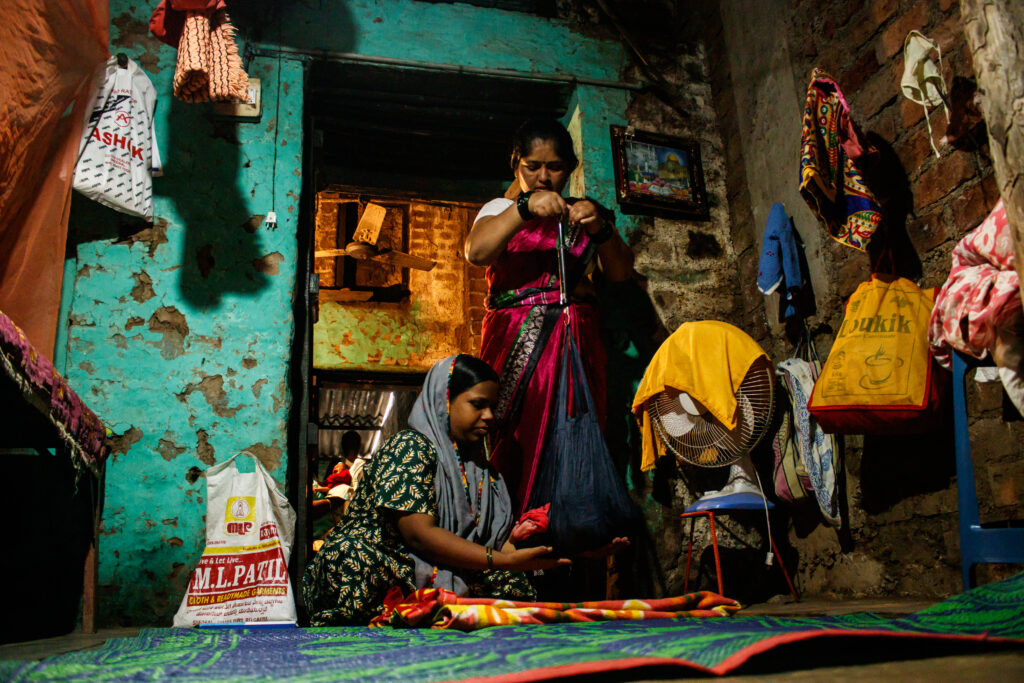
Hasina Hajukhan never imagined that returning to her maternal house would turn into a near-death experience. In April, the 28-year-old was seven months pregnant, and her medical parameters were normal. “I was taking extra care to ensure no complications during childbirth,” she told Toward Freedom.
As is customary in many parts of India, pregnant women return to their parents’ homes to give birth. When Hajukhan first reached her mother’s house in Ganeshwadi village of the western Indian state of Maharashtra, she felt nauseated. “It was April’s final week, and I couldn’t even breathe properly,” she recounted. A heat wave had taken hold. “The climate was the stark opposite of what it was in my husband’s village.” In Ganeshwadi, things kept getting complicated with the rising heat. “Every day, I was breathless and would feel dizzy.”
Using a desk fan at the highest speed didn’t help, as it just circulated more hot air. An air conditioning system was something her family could not afford. The tin sheet roof would get extremely hot. During this crucial time, Hajukhan needed rest. However, she spent most of her day stepping out to gasp for cold air. In May’s final week, things got worse. “I felt as if I was going to die,” she recalled, teary-eyed.
Immediately, her mother dialed Ranjana Gavade, an accredited social health activist (ASHA worker), part of a community of 1 million women healthcare workers appointed for every 1,000 people in India’s villages. ASHAs are responsible for more than 70 healthcare tasks, with a particular focus on maternal and child health.
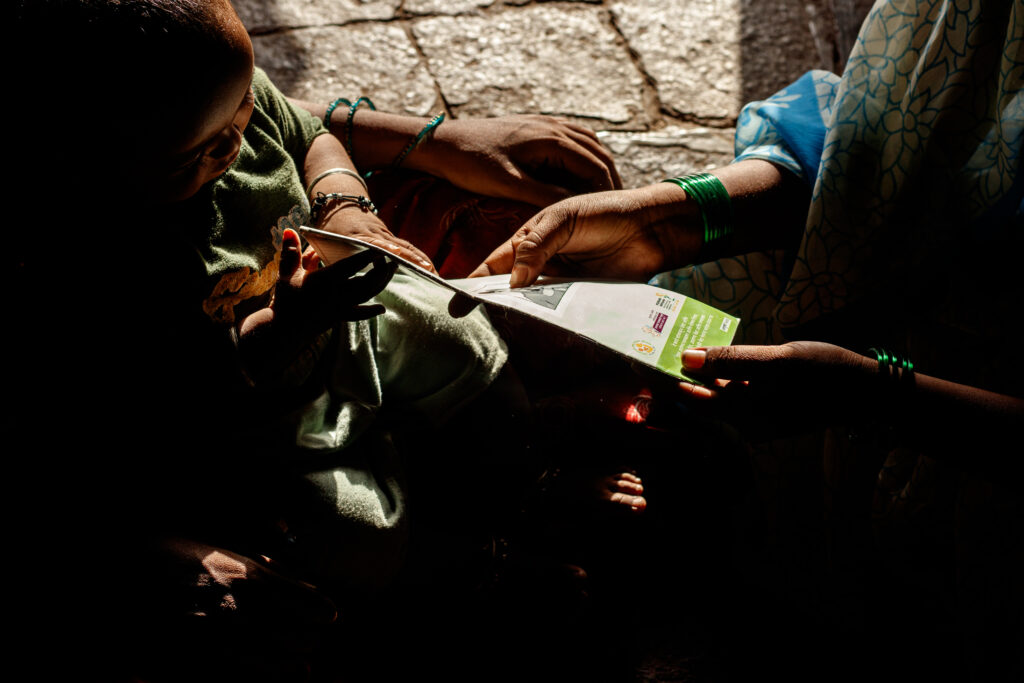
“I was worried looking at her rapidly deteriorating health and informed my colleagues.” Upon their instructions, Gavade called a government ambulance and swiftly took her to the district hospital, 33 kilometers (20.5 miles) away. Hajukhan gave birth to underweight twins. Her troubles still hadn’t ended when she was discharged after three days. For a month since then, Hajukhan has been trying to ensure her twins gain weight, but all efforts have failed. As a result, they weren’t administered the necessary Bacillus Calmette–Guérin (BCG vaccine used against tuberculosis), Hepatitis B, and Polio vaccines.
The Kolhapur district, where Hajukhan lives, has been reporting recurring floods, heat waves, incessant rainfall, and hailstorms triggered by climate change. She said everything would have been normal had she not returned to her parents’ home to give birth in the heat waves. “My children wouldn’t have had to live such a dangerous life,” she said.
Like in the village of Ganeshwadi, climate change impacts have been delaying children’s immunization schedules throughout India, making them vulnerable to diseases. Research has found that if a child belonged to a district highly vulnerable to climate change, the odds of stunting rose by 32 percent, low weight by 45 percent, anemia by 63 percent and acute malnutrition by 42 percent. An analysis by global nonprofit Save the Children found that, globally, 774 million children are living in poverty and at a high risk of climate-related disasters. Weather disasters ranging from floods to droughts prevent children from obtaining nourishment, causing low weight, and these disasters put a break on children receiving vaccinations on time. Their weakened immune systems, as a result of a lack of proper nourishment in crisis times, make them vulnerable to other diseases. Being sick can halt the necessary immunizations, and these delays have led to a rise in epidemics and diseases.
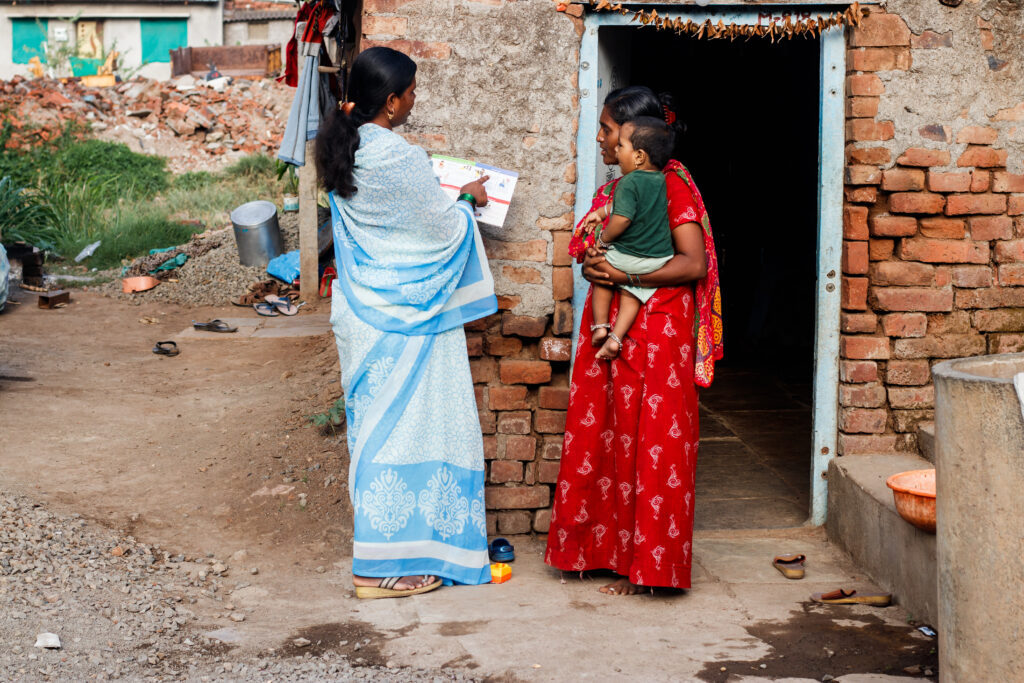
How Floods Impact Universal Immunization
Snehal Kamble, 24, a resident of Maharashtra’s flood-prone Arjunwad village, remembers the year 2019 in meticulous detail. “A day before the floods, I was preparing to go to my parent’s house.” Five months pregnant, she was looking for iron folic acid tablets. “Instead, all of us went to a flood relief camp,” she recounted. From there, she moved to another relief camp within a few days, as the water rose further. “During this time, I was worried about my house and belongings,” she said. She fell sick and was away from home for 15 days. “Those were the most difficult days of my life,” she shared. Then in January 2020, she gave birth to a boy named Sangarsh, who has often fallen sick. “When I went to my maternal house, he just couldn’t bear the heat there,” she said. The dehydration and spells of fever he experienced affected his immunization schedule. “His Pentavalent vaccine was delayed by several months because of health ailments,” said ASHA worker Shubhangi Kamble (no relation to Snehal), who has been monitoring this child since birth.
Further, his Measles-Rubella vaccine and Vitamin A dose were also delayed, making him vulnerable to diseases. “Vaccines need to be administered on time,” said Sachin Kamble, a nursing officer at the district women’s hospital in Maharashtra’s Osmanabad district. “Otherwise, it affects a child’s immunity, making them more vulnerable to diseases.”
He pointed out how the lack of vaccinations led to 2,692 cases in 2022 in Maharashtra, which reported the highest measles count in India. That was an eight-fold increase from the previous year. During this time, India reported 12,773 cases. India’s National Family Health Survey (NFHS) said only 31.9 percent of children ages 24 months to 35 months had received a second dose of measles-containing vaccine in 2019-21.
Another healthcare worker, Kavita Magdum, from flood-affected Ganeshwadi village, said that children in her surveying area never fell ill so frequently. She started noticing such stark changes only in the past five years. Upon inspecting this, she found, “Stress caused by the changing climate is leading to this.” For instance, Magdum sees that many children aren’t drinking breast milk, which has impacted their medical parameters. These drastic changes reflect in Indian government statistics, as well. During 2015-16, 58.6 percent of children ages 6 months to 59 months (just under 5 years old) were anemic in India. By 2019-20, this number rose to 67.1 percent. In addition, 32 percent of children nationally remain underweight.
After a year-and-a-half, Snehal’s son started getting better, thanks to Shubhangi’s consistent visits, when she monitored every parameter and ensured the best possible treatment by working hours beyond her duty. “Once the vaccination schedule started falling in place, his health, too, began improving,” Shubhangi shared.
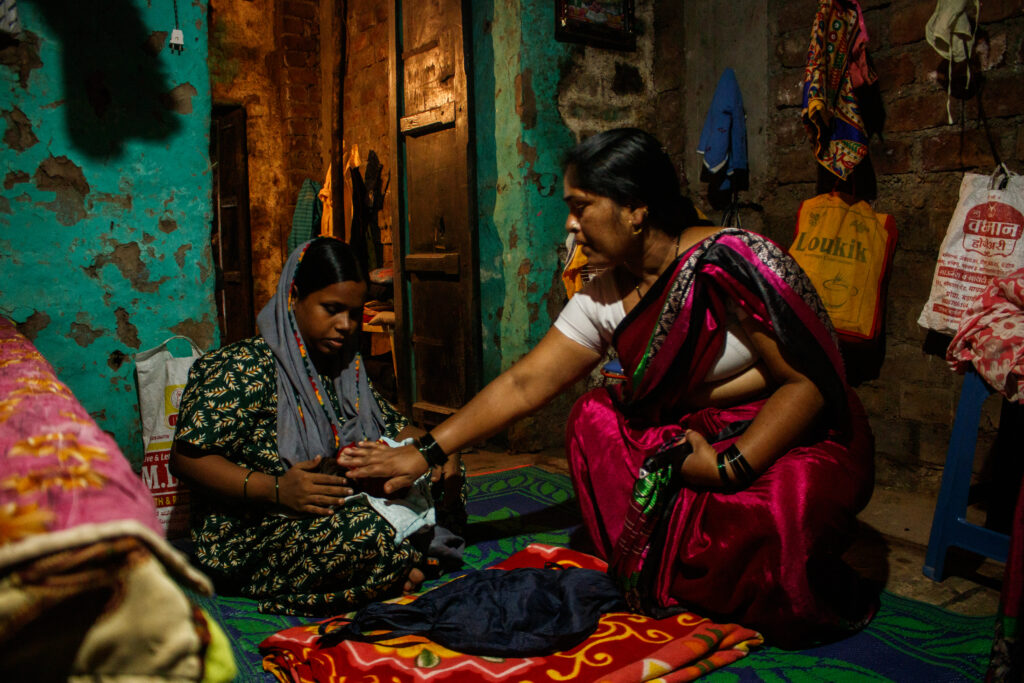
Untimely Administration of Vaccines
While climate change is making it difficult for these healthcare workers to complete universal immunization, another challenge is the untimely vaccine administration.
“There are many instances, where vaccines in several villages are just not available,” said Netradipa Patil, leader of more than 3,000 ASHA workers and co-founder of Deep-Maya Foundation, a non-profit that works for women and children. “During such times, it becomes extremely challenging for us healthcare workers to manage everyone.”
Patil has observed that the workload has increased tremendously for all the ASHA workers because of the delay in vaccination. This is because ASHA workers are responsible for immunization, and in case of any discrepancy or error, they are held accountable. Research published in 2016 concluded, “Lack of timely administration of key childhood vaccines, especially DPT3 (the three doses of the Diphtheria, Tetanus and Pertussis vaccine) and MCV (measles-containing vaccine), remains a major challenge in India and likely contributes to the significant burden of vaccine-preventable disease-related morbidity and mortality in children.” Another paper published in 2019 inferred, “The proportion of children with delayed vaccination is high in India.”
In 2021, the World Health Organization found that 25 million children around the world under the age of 1 didn’t receive vaccines, a figure not seen since 2009. “Many children never get the Vitamin A doses on time. These doses are just not available when required,” Patil said, suggesting the Indian government should consult local healthcare workers to arrange vaccination. “We need to reach more and more people, and, currently, looking at the changing climate, we aren’t prepared to do this,” she shared. Patil made simple suggestions like identifying vulnerable children and their locality and monitoring them from the earlier stages, even before the disaster strikes. “Just by proper identification, we can save so many children,” she said.

Rising Undernourishment
Fed up with feeding medications and tonics that didn’t seem to help increase his weight and prevent him from continually falling ill due to the changing weather conditions, Rashi Patil, 23, quit taking her son to the doctor every month after 18 months. “My son just wouldn’t eat anything,” Patil said.
Moreover, the changes in local climatic patterns affected her son’s health, and he often fell sick. Last year, he was hospitalized for a week as his platelets fell and a fever intensified. What followed next were recurring illnesses that delayed his immunization schedule. Because of the fever in March, he wasn’t administered the Pentavalent 1 vaccine (it protects from five life-threatening diseases: Diphtheria, Pertussis, Tetanus, Hepatitis B and Hib [Haemophilus Influenzae Type b]). Her son soon became weak and began recovering only after the vaccine’s administration. All this while, her son struggled with good eating habits. After several trials and errors, Rashi and her husband, Rajkumar, discovered the climate affected their son’s health and eating habits.
“Now, their son makes it a point to eat only outside the house, where he gets some cold air,” says Rashi. “Contrastingly, this was never the case with my elder daughter.”
Toward Freedom reached out to Ganeshwadi’s community health officer, Dr. Prajakta Gurav, regarding what steps her team was taking to deal with delayed immunization. Gurav hasn’t replied as of press time.
The impact of poor diets is more obvious at the national level. For instance, just 11.3 percent of children between the ages of 6 months and 23 months receive an adequate diet. Plus, in 2022, India ranked 107 out of 121 countries on the global hunger index. These numbers further reveal how climate change is exacerbating the existing faultlines.
The problem is not restricted to India. Of the countries at severe risk of being adversely affected by climate change, the report by Save the Children says, “Burundi has the highest rate of stunted children (54 percent), followed by Niger (47 percent), Yemen (46 percent), Papua New Guinea (43 percent), Mozambique (42 percent) and Madagascar (42 percent).”
Research published in PLOS Medicine found that in 22 sub-saharan African countries, drought led to lower chances of completion of BCG (Bacillus Calmette-Guérin), Polio and DPT (diphtheria, tetanus, and pertussis) vaccines. “We took vaccines to the last mile. Now, climate change is eroding progress.”
For Komal Kamble, 30, vaccinating her 2-year-old daughter remains challenging. Her remote mountainous village of Kerle, in Maharashtra’s Kolhapur district, remains inaccessible most of the year.
For the village population of less than 1,100 people, the nearest healthcare facility is 15 kilometers away. Last year, within a week of October rains, the road that connects her village to the nearest hospital was completely under floodwater.
Komal’s daughter couldn’t get proper medical care for two days, worsening her health. Her chest was full of cough, and the fever rose, making things difficult for the agrarian Kamble family. This wasn’t restricted to heavy rainfall, though. Since her birth in 2021, Komal has taken her daughter to a private doctor at least 20 times, spending over Rs 15,000 ($182). Last year, she was feverish and wasn’t given the crucial Japanese encephalitis vaccine, a Vitamin A dose and the Measles-Rubella vaccine. This made her vulnerable to more diseases, challenging the Kamble family.
Healthcare worker Shubhangi Kamble from Arjunwad says that instances of children missing their vaccination are rising rapidly. When she went to find out why this was happening in her village, Arjunwad, she saw that children fell sick during floods and heat waves. “This was the time that coincided with their vaccination schedule, and so many couldn’t get the vaccines,” she shared.
However, a delay in vaccination has caused more problems than she had anticipated.
“Almost every day, at least one parent dials me asking where they should get their children hospitalized,” she said.
Now, every rainfall brings a health issue for Komal’s daughter. “I am tired of going to the healthcare center to hear that my daughter is underweight or sick and can’t be given the vaccine,” Komal said, with frustration in her voice.
Meanwhile, with every climate disaster, it will become increasingly difficult for many families to complete the immunization in time. “I’ve been vaccinating children for over a decade, but things never got this difficult. We took vaccines to the last mile. Now, climate change is eroding progress,” said healthcare worker Kavita Magdum.
Sanket Jain is an independent journalist based in the Kolhapur district of the western Indian state of Maharashtra. He was a 2019 People’s Archive of Rural India fellow, for which he documented vanishing art forms in the Indian countryside. He has written for Baffler, Progressive Magazine, Counterpunch, Byline Times, The National, Popula, Media Co-op, Indian Express and several other publications.

‘If India Can Do It, Why Not Europe?’: Researchers Lay Out Case for Re-wilding European Landscape

Editor’s Note: This article previously specified the species of wolf, as well as the time frame, to which it was hunted to extinction. What experts say is a missed opportunity in a European Commission proposal has been clarified. Captions for the first and third photos have been corrected.
The Swedish government is planning to cull the country’s wolf population by half. The plan faces little to no resistance in the Swedish parliament, given a majority are in favor of the proposal. But conservationists, other experts and Green Party MPs have warned the move could be a breach of biodiversity laws in the European Union (EU), risking the country being dragged to court. The issue, though, is part of a much larger and graver problem.
Europe has lost most of its mega herbivores (those weighing more than 1,000 kilograms or 2,204 pounds), 75 percent of species weighing more than 100 kg (220 pounds) and a little over half of its terrestrial mammals weighing more than 10 kg (22 pounds), a new paper points out.
And, of the species that survive today, many have reduced ranges and numbers. Suffice to say, proposals to further cull wildlife populations can only accelerate the extinction crisis. But all is not lost. At least, not yet.

How Large Mammals Can Make a ‘European Comeback’
The paper charts a path for re-wilding Europe with large mammals, or those weighing more than 10 kg (22 pounds), both for conserving biodiversity and restoring ecosystems. It lists species, state of extinction risks, and ways of restoration, such as natural recolonization and reintroduction.
And, all this, the paper argues, is a legal obligation for Europe in light of a host of EU and international laws, including the Convention on Biological Diversity (CBD) that requires Europe to restore both the diversity and density of its megafauna. More specifically, Article 8(f) of CBD states every party that has signed onto the agreement “shall, as far as possible and as appropriate … rehabilitate and restore degraded ecosystems and promote the recovery of threatened species, inter alia, through the development and implementation of plans or other management strategies.”
Additionally, the paper states, Europe has a moral obligation to re-wild in solidarity with the Global South, which is currently doing the heavy lifting when it comes to biodiversity preservation.
“Legal obligations have definitely played a role in some real-life scenarios, such as the legal protection of wolves which has clearly aided the species’ European comeback,” Arie Trouwborst, lead author of the paper and associate professor at Tilburg Law School, told Toward Freedom.
However, in the context of general commitments to restore ecosystems, “large mammals, especially those which disappeared from Europe long ago, like elephants and lions, have largely been a blind spot—wrongly so, as our paper aims to show,” he added. No examples exist of European governments undertaking such a feat with the Global South in mind.
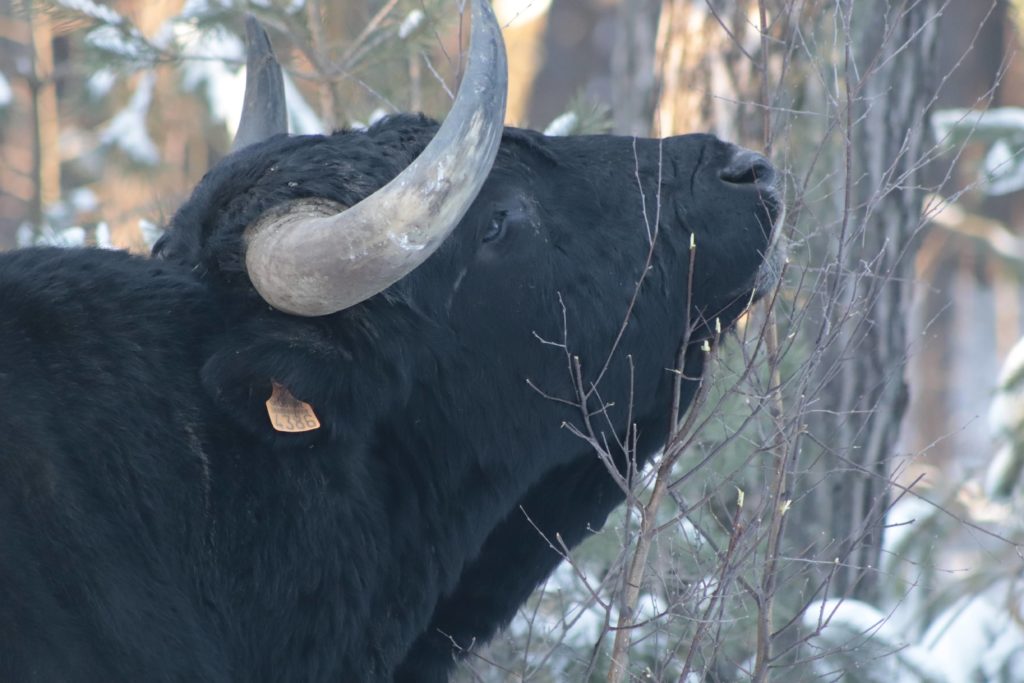
‘Life Goes On After Wolves Come Back’
Large mammals play a critical role in ecosystem restoration or even in ecosystem functions in general. Elaborating on the same, Jens-Christian Svenning, co-author on the paper, listed out three key reasons why:
- Large herbivores tend to promote heterogeneity in vegetation structure and composition as well as in soil conditions, while large carnivores contribute to this effect by modulating herbivore assemblage composition, densities and behavior, in complex ways;
- megafauna constitute and generate microhabitats for numerous other species, dependent on their living bodies, their carcasses, and their dung; and lastly,
- megafauna species are mobile and play important roles in plant and nutrient dispersal, which is crucial to maintaining local landscapes and in assisting the fight against climate change.
As for ill-thought out calls to cull wildlife, like the Swedish plan to reduce wolf populations by half, the paper says in recent decades, people in countries like Germany and France have “quickly discovered that life goes on after wolves come back.” The sentiment is also true for larger mammals that are generally considered more dangerous for human life, like brown bears, which have been successfully reintroduced in Italy’s Trento region.
The expansion of wolves in Europe is also a result of strong legal protections. Wolves were not reintroduced in Europe. Rather, they naturally began expanding into areas in which they existed before. And legal instruments like the Bern Convention and Habitats Directive assisted such expansion by ensuring countries that wolves had moved into protected them. Earlier, wolves were hunted to extinction in large parts of Europe.
The Habitats Directive has been crucial for the restoration of wolves in Europe. “It’s obvious when you compare wolf numbers in EU states that are bound by the Directive—like Sweden—to those in countries which are not, like Norway,” Trouwborst said. “Wolves have been trying to make a comeback in both countries, but they have not been successful in Norway.”
The Directive provides room for enforcing conservation action, both by the European Commission and via national courts.
Regarding even more challenging species reintroduction candidates, the paper says if people in India can co-exist with lions and elephants, and people in Tanzania and Zimbabwe can do so with hyenas and hippos, “then surely this is also possible in Europe.”
India’s population density stands at 464 people per square kilometer (or 0.38 of a square mile), as opposed to 34 people per square kilometer in Europe. And yet, the paper points out, people in India still share the landscape with elephants, rhinos, gaur (Indian bison), tigers, lions, leopards, snow leopards, caracals (a wild cat), brown bears, wolves and others.

Addressing Equity in Restoration Models
Apart from CBD and EU biodiversity laws, another campaign demands decadal commitments and efforts. The United Nations has recognized the years between 2021 and 2030 as the “Decade on Ecosystem Restoration.” A guidebook on such restoration efforts points to re-wilding in Europe where “there is enough space and opportunity to introduce species that have been lost.”
But the question is “restore to what?” In other words, what is the reference point or model that could illustrate what the world needs to go back to?
“Large mammals play a key role in ecosystems and many of them disappeared due to human interference. So the big picture… the model must be the healthy ecosystems that occurred before humans wiped out many of the largest of species,” Trouwborst explained. Such models can be found today, which could be the basis for restoration in Europe. Some European ecosystems looked like versions of modern-day east and south Africa, as well as India, with elephants, hyenas, lions, rhinos and hippos.
“As Europeans we cannot keep expecting those in the Global South to continue conserving and even restoring healthy ecosystems abundant in megafauna and not take that seriously ourselves,” Trouwborst said. In addition to solidarity with the Global South, another moral argument is “you should restore what you destroyed,” he added.
The reference in Article 8(f) of CBD to “as far as possible and as appropriate,” is about equity, legal scholars point out. It is equivalent to the principle of “common but differentiated responsibilities and respective capabilities” (CBDR-RC) enshrined in the United Nations Framework Convention on Climate Change. The principle refers to developed countries being held responsible for undertaking a majority of climate action because of their historical greenhouse gas emissions. That, plus their capacity—financial in particular—to shoulder such burdens.
Carina Bury, a PhD candidate in International Environmental Law at the University of Hamburg in Germany, explained that qualifiers such as “as far as possible” that are often encountered in international environmental law should be read in light of CBDR-RC. In practice, what this also means is if someone says elephants in Europe is not plausible, then, Trouwborst argued, “I’d say look at India. If it’s possible in India, then why not in Europe? It would take some small and some big sacrifices but it’s not impossible. It’s a question of priority.”
Other researchers also have pointed out the question of equity is absent when international environmental law has been implemented.
“I found that Germany omitted to implement the treaty in the manner required by the constitution. The consequence is that the treaty remains largely inapplicable, but it puts pressure on states of the global South—such as Montenegro—to implement the same treaty,” she said of her research that found Germany neglected to conserve its wetlands. Ramsar Convention is an international treaty signed in 1971 that regulates the conservation and sustainable use of wetlands.
This reporter reached out to the federal environment ministry in Germany for a response. The copy will be updated if and when a response is received.
Considering Germany is a country with significantly above-average levels of wealth and technical know-how, it is “possible, and indeed reasonable to expect that wetlands located in German territory be managed as green infrastructure,” Bury said. She also added that when countries with sufficient resources and technical knowledge start to neglect their international obligations, less-advantaged countries are less likely to comply.
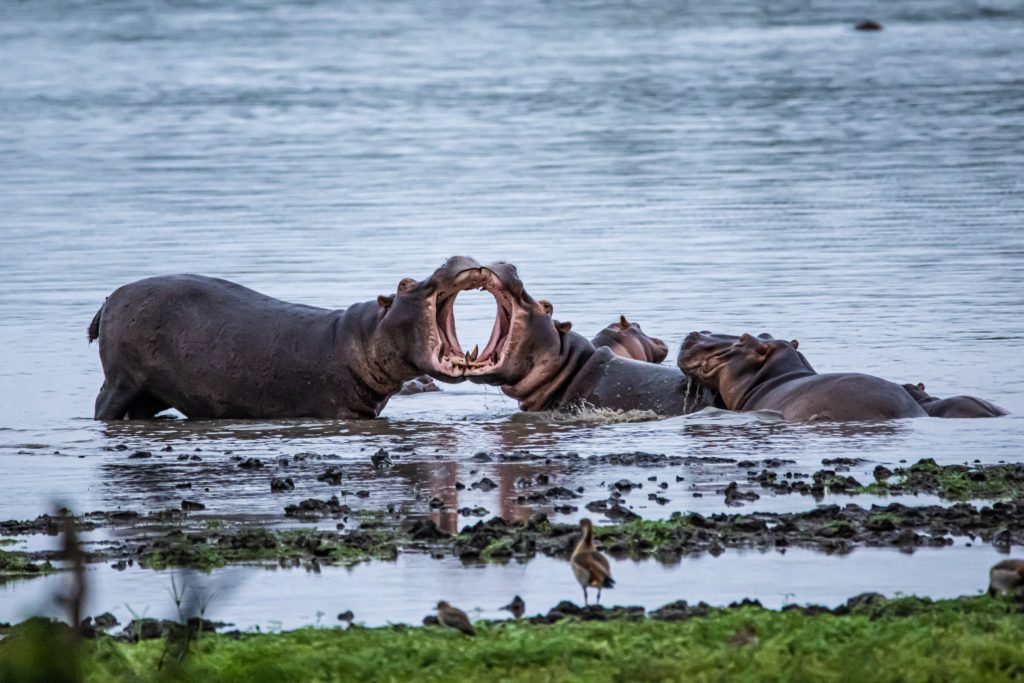
New Hope with Europe’s New Nature Restoration Law?
On June 22, the European Commission put forth a proposal for a new “Nature Restoration Law” that aims to halt both biodiversity loss and the degradation of ecosystems. The draft law aims to address a variety of ecosystems—including agricultural lands, marine habitats and urban areas—and it lays out targets to be met by 2030, 2040 and 2050.
But experts have pointed out a huge missed opportunity because the proposal does not highlight the importance of megafauna for ecosystem restoration. Plus, the proposal only focuses on those species that are included in the Habitats Directive, not those that had long ago disappeared from the European landscape. The European Commission is yet to respond to these critiques.
So while there are legal hooks in the proposal that could help restoration efforts for some large mammals,” the proposal ignores current scientific knowledge as to what healthy and well-functioning European ecosystems really looked like,” Trouwborst pointed out.
This story was developed as part of a journalism residency program at Max Planck Institute for Comparative Public Law and International Law (MPIL) in Heidelberg, Germany.
Rishika Pardikar is an Indian journalist who reports on climate change and biodiversity. She is currently a journalist-in-residence at MPIL in Heidelberg, Germany.

The Western Allied Nations Bully the World While Warning of Threats From China and Russia

Editor’s Note: This analysis was produced by Globetrotter.
On January 21, 2022, Vice Admiral Kay-Achim Schönbach attended a talk in New Delhi, India, organized by the Manohar Parrikar Institute for Defense Studies and Analyses. Schönbach was speaking as the chief of Germany’s navy during his visit to the institute. “What he really wants is respect,” Schönbach said, referring to Russia’s President Vladimir Putin. “And my god, giving someone respect is low cost, even no cost.” Furthermore, Schönbach said that in his opinion, “It is easy to even give him the respect he really demands and probably also deserves.”
The next day, on January 22, Ukraine’s Foreign Minister Dmytro Kuleba summoned Germany’s ambassador to Ukraine, Anka Feldhusen, to Kyiv and “expressed deep disappointment” regarding the lack of German weapons provided to Ukraine and also about Schönbach’s comments in New Delhi. Vice Admiral Schönbach released a statement soon after, saying, “I have just asked the Federal Minister of Defense [Christine Lambrecht] to release me from my duties and responsibilities as inspector of the navy with immediate effect.” Lambrecht did not wait long to accept the resignation.
Why was Vice Admiral Schönbach sacked? Because he said two things that are unacceptable in the West: First, that “the Crimean Peninsula is gone and never [coming] back” to Ukraine and, second, that Putin should be treated with respect. The Schönbach affair is a vivid illustration of the problem that confronts the West currently, where Russian behavior is routinely described as “aggression” and where the idea of giving “respect” to Russia is disparaged.
Aggression
U.S. President Joe Biden’s administration began to use the word “imminent” to describe a potential Russian invasion of Ukraine toward the end of January. On January 18, White House Press Secretary Jen Psaki did not use the word “imminent,” but implied it with her comment: “Our view is this is an extremely dangerous situation. We’re now at a stage where Russia could at any point launch an attack in Ukraine.” On January 25, Psaki, while referring to the possible timeline for a Russian invasion, said, “I think when we said it was imminent, it remains imminent.” Two days later, on January 27, when she was asked about her use of the word “imminent” with regard to the invasion, Psaki said, “Our assessment has not changed since that point.”
On January 17, as the idea of an “imminent” Russian “invasion” escalated in Washington, Russia’s Foreign Minister Sergei Lavrov rebuked the suggestion of “the so-called Russian invasion of Ukraine.” Three days later, on January 20, spokeswoman for Russia’s Foreign Ministry Maria Zakharova denied that Russia would invade Ukraine, but said that the talk of such an invasion allowed the West to intervene militarily in Ukraine and threaten Russia.
Even a modicum of historical memory could have improved the debate about Russian military intervention in Ukraine. In the aftermath of the Georgian-Russian conflict in 2008, the European Union’s Independent International Fact-Finding Mission on the Conflict in Georgia, headed by Swiss diplomat Heidi Tagliavini, found that the information war in the lead-up to the conflict was inaccurate and inflammatory. Contrary to Georgian-Western statements, Tagliavini said, “[T]here was no massive Russian military invasion underway, which had to be stopped by Georgian military forces shelling Tskhinvali.” The idea of Russian “aggression” that has been mentioned in recent months, while referring to the possibility of Russia invading Ukraine, replicates the tone that preceded the conflict between Georgia and Russia, which was another dispute about old Soviet borders that should have been handled diplomatically.
Western politicians and media outlets have used the fact that 100,000 Russian troops have been stationed on Ukraine’s border as a sign of “aggression.” The number—100,000—sounds threatening, but it has been taken out of context. To invade Iraq in 1991, the United States and its allies amassed more than 700,000 troops as well as the entire ensemble of U.S. war technology located in its nearby bases and on its ships. Iraq had no allies and a military force depleted by the decade-long war of attrition against Iran. Ukraine’s army—regular and reserve—number about 500,000 troops (backed by the 1.5 million troops in NATO countries). With more than a million soldiers in uniform, Russia could have deployed many more troops at the Ukrainian border and would need to have done so for a full-scale invasion of a NATO partner country.
Respect
The word “respect” used by Vice Admiral Schönbach is key to the discussion regarding the emergence of both Russia and China as world powers. The conflict is not merely about Ukraine, just as the conflict in the South China Sea is not merely about Taiwan. The real conflict is about whether the West will allow both Russia and China to define policies that extend beyond their borders.
Russia, for instance, was not seen as a threat or as aggressive when it was in a less powerful position in comparison to the West after the collapse of the USSR. During the tenure of Russian President Boris Yeltsin (1991-1999), the Russian government encouraged the looting of the country by oligarchs—many of whom now reside in the West—and defined its own foreign policy based on the objectives of the United States. In 1994, “Russia became the first country to join NATO’s Partnership for Peace,” and that same year, Russia began a three-year process of joining the Group of Seven, which in 1997 expanded into the Group of Eight. Putin became president of Russia in 2000, inheriting a vastly depleted country, and promised to build it up so that Russia could realize its full potential.
In the aftermath of the collapse of the Western credit markets in 2007-2008, Putin began to speak about the new buoyancy in Russia. In 2015, I met a Russian diplomat in Beirut, who explained to me that Russia worried that various Western-backed maneuvers threatened Russia’s access to its two warm-water ports—in Sevastopol, Crimea, and in Tartus, Syria; it was in reaction to these provocations, he said, that Russia acted in both Crimea (2014) and Syria (2015).
The United States made it clear during the administration of President Barack Obama that both Russia and China must stay within their borders and know their place in the world order. An aggressive policy of NATO expansion into Eastern Europe and of the creation of the Quad (Australia, India, Japan and the United States) drew Russia and China into a security alliance that has only strengthened over time. Both Putin and China’s President Xi Jinping recently agreed that NATO’s expansion eastward and Taiwan’s independence were not acceptable to them. China and Russia see the West’s actions in both Eastern Europe and Taiwan as provocations by the West against the ambitions of these Eurasian powers.
That same Russian diplomat to whom I spoke in Beirut in 2015 said something to me that remains pertinent: “When the U.S. illegally invaded Iraq, none of the Western press called it ‘aggression.’”
Vijay Prashad is an Indian historian, editor and journalist. He is a writing fellow and chief correspondent at Globetrotter. He is the chief editor of LeftWord Books and the director of Tricontinental: Institute for Social Research. He is a senior non-resident fellow at Chongyang Institute for Financial Studies, Renmin University of China. He has written more than 20 books, including The Darker Nations and The Poorer Nations. His latest book is Washington Bullets, with an introduction by Evo Morales Ayma.
